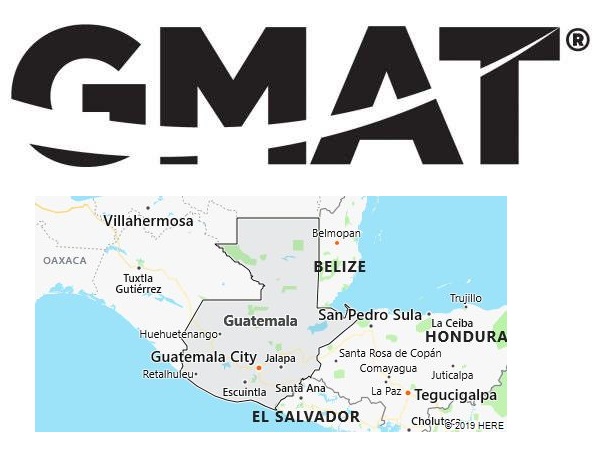GMAT Testing Location
We have found 1 GMAT test centre in Guatemala. For specific test dates of 2019, please refer to the end of this page.

Universidad Galileo
7 Avenida final Zona 10
calle Dr. Eduardo Suger Cofiño
Torre 1 4to. Nivel Oficina 418
01010 Guatemala
Guatemala
Phone: 2423-8000 EXT.7132
Test Center Information
El edificio de la Universidad Galileo se encuentra ubicado al final de la 7av. Zona 10 donde se ubicaba el Balneario Ciudad Vieja.
Las Oficinas de Registro de Evaluacion está en el Edificio Dr. Manuel Ayau Torre 1, 4to. nivel Oficina 418.
ENTRAR A PARQUEO SIN COSTO EN LA GARITA DE UNIVERSIDAD GALILEO. INDICAR QUE ASISTE A HACER EXAMEN DE CERTIFICACIÓN INTERNACIONAL.
The Universidad Galileo building is located at the end of 7th Avenue, Zone 10 where the Balneario Ciudad Vieja once was.
The offices of Registration are in the Dr. Manuel Ayau building, tower 1, 4th floor, office 418.
YOU CAN ACCESS FREE PARKING TELLING AT THE UNIVERSIDAD GALILEO PRINCIPAL VEHICLE ENTRANCE THAT YOU COME TO TAKE AN INTERNATIONAL CERTIFICATION EXAM.
GMAT Exam Dates in Guatemala
Unlike some paper based exams, the GMAT is computer based. Therefore, there are no fixed test dates for GMAT. Wherever you are in Guatemala, all test centers are open from Monday through Saturday throughout the year. Some even offer the exam every day of the year. However, some test centers are not open on Sundays and national holidays. For example, most college-based test centers might be closed for extended periods around holidays. For precise testing dates in Guatemala, please visit test-maker website – https://www.mba.com/.
More about Guatemala
Geography
In the north of Guatemala, on the Yucatán peninsula, lies the hill and marshland of Peten. The southern part is traversed in a west-east direction by mountain ranges of the Central American Cordilleras, of which the northern in the Altos Cuchumatanes reach 3,800 m above sea level. The Sierra Madre to the south is dominated by 33 volcanoes. In between there are scenic lakes such as the Atitlán.
The climate is tropical. The rainy season is from May to November. The mean annual temperatures are 25–30 ° C in the lowlands and less than 12 ° C in mountainous areas. The Petén is covered by an ever-humid rainforest, in the center also covered by pine savannas. While the mountainous regions facing the wind carry tropical mountain and cloud forests, oak-pine mixed forests and savannas appear in the drier inland highlands. The Pacific coastal lowlands are occupied by wet forest in the west and dry forest in the east. Jaguar, which has now become rare, live in the forests, as do pumas, wrapped bears and howler monkeys. Tapirs occur in the tropical rainforest of the Petén. The dove-sized quetzal is common from Mexico to Panama. He is the heraldic bird of Guatemala and namesake of the national currency. His splendid feathers were once used by the priests and kings of the indigenous population as headdresses, and he himself was worshiped as a deity. Today the quetzal is endangered. Other bird species include toucans, macaws and hummingbirds.
Environmental problems arise from uncontrolled logging, especially of valuable mahogany and cedar wood, and clearing to gain land for plantations, pastures and oil production sites. Consequential damage is erosion and lack of water. The ground and surface water is polluted by crude oil, the discharge of industrial wastewater and the use of pesticides. About 30% of the country’s area is under nature protection.
Population and Religion
In Guatemala, the indigenous population has a relatively high proportion of around 38%. It includes, for example, the Maya and Xinca ethnic groups. 56% of the Guatemalans are descendants from the connection between Europeans and members of the indigenous peoples (German mestizos), who are called Ladinos in the country. White and black people each make up 2% of the population. The latter live in the hot, humid Caribbean coastal lowlands. Another minority are the Garífuna or Black Caribs with a share of 1%. These are mixed descendants of Carib and African slaves. In addition to the official Spanish language, over 20 Mayan languages are spoken in numerous dialects.
Guatemalan society is characterized by stark social contrasts. On the one hand there is the small, economically and culturally ruling white upper class, which also owns most of the land, on the other hand the indigenous population. It has little influence in politics, administration and economics. Around 60% of them live below the poverty line.
43–48% of the population belong to the Catholic Church, around 38–44% to Reformation denominations. The religious minorities (less than 3% of the population) include Buddhists, Hindus, Muslims and Jews. The pre-Christian Maya religion has survived to a small extent among the indigenous population to this day. In everyday life, however, elements of the Mayan religion were combined with Catholicism. More than 10% of all residents cannot be assigned to any religion.
